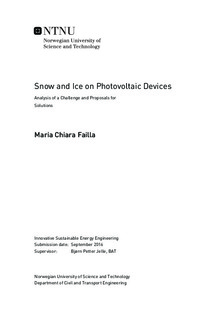| dc.description.abstract | The global photovoltaic industry is a rapidly growing and highly competitive, innovation-based sector. Norway s interest in photovoltaics has been behind other countries for a long
time; however a recent impulse in the solar industry has developed, driven by the necessity of reducing buildings impact on environment.
As a matter of fact Norwegian interest in photovoltaics leads to the study of the influence of snow on PV devices. As a consequence, different studies have been conducted to find an
adequate solution to the problem.
First of all the snow condition is described through statistical data and graphs in the most
populated cities of Norway: Oslo, Bergen and Trondheim. In addition the will of Norwegian
industry and research to address to renewable resources is underlined. As a consequence, the
motivation and the interest in this thesis topic appear clear.
The second part of the thesis gives some guidelines about the geometric design of a PV-plant
taking in consideration the accumulation of snow on the panels. Different answers are given
for different plan conditions. When the modules are all located on the same shed, a high tilt
angle can be more convenient than a low one, because it increases the sliding of snow. On the
contrary, when panels are located on different sheds, the shading problems leads to the
conclusion that a medium tilt angle is the best solution. Other indications are given regarding the division of the system electrically, through string diodes and module by-pass diodes. In conclusion this part is addresses to who is approaching in designing a new PV-plant.
The third part focuses on computation of snow loss; therefore it is applicable to existing PV
systems. An application of Marion s algorithm and the PVsyst software on the ZEB Living
Lab PV-plant supposed in Oslo, Bergen and Trondheim gives interesting results about the
snow loss values. They are strongly related to the snow depth, solar radiation and air
temperature, therefore a deep connection to the location weather data is present. The monthly
snow loss percentage reaches values till 70% in Oslo, while lower percentages characterize
the other sites. However the annual loss is around 3% in Oslo and Trondheim and around 1%
in Bergen.
Possible solutions to avoid or reduce snow accumulation on the PV panels are investigated in
the fourth chapter. Then a focus on the icephobic coatings was presented. Their characteristics, their design, their properties were studied to know how useful these elements can be to our case. Finally a spotlight on the state-of-art showed the possibilities that are nowadays offered by the market.
The fifth chapter copes with a hypothesis of simulation of icephobic coatings on the PV
modules, to have an idea of their contribute in term of energy save. Moreover the fact that
soiling loss is reduced as well should be taken in consideration. The simulations were
conducted for the same PV-plant supposed in Oslo, Bergen and Trondheim in the third part,
so that differences between the two cases were highlighted. | |

